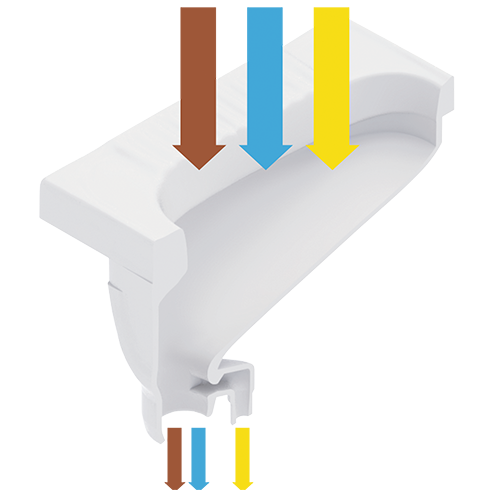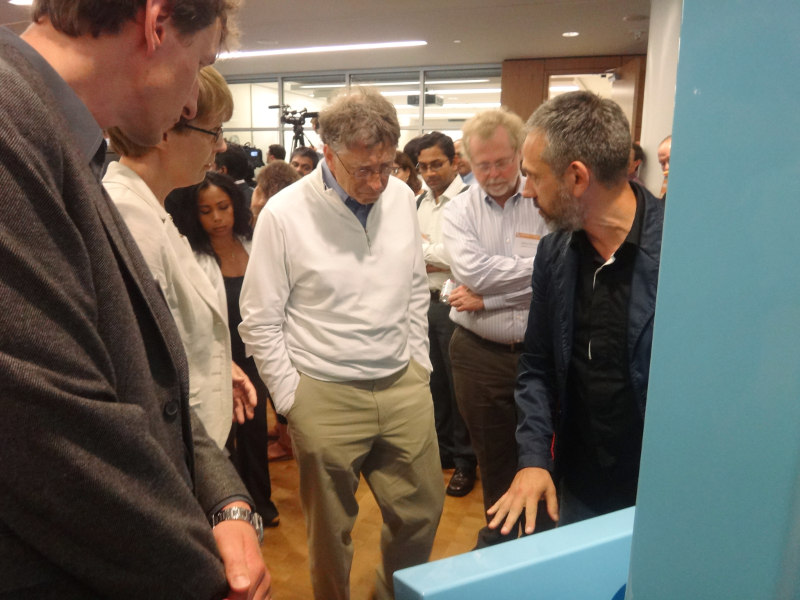Technology

System
Scheme of a Three-Stream Separation System
In order to separate urine, solids, and water for further treatment in backend systems, the
system combines a urine diverting flush toilet as a frontend technology and a liquid solid
separator. In the first treatment step the “Urine Trap” separates urine from flush water and
feces at source. In a second treatment step a liquid-solid separator (in the test setup a
commercially available product from Aquatron in Sweden) separates the liquid fraction (feces
water) from the solids (feces and toilet paper).
Backend technologies profit from significantly reduced nitrogen and phosphorous loads
in the feces water stream as well as from a nearly undiluted urine stream. Solids have only
little water content for further treatment. The three-stream separation system reduces the
energy required for further backend treatment processes.

Application
Universal Application
The “Urine Trap” can be universally applied to all typologies of wash-down toilet designs: pedestal or squat pan, cistern flush or pour flush, washers or wipers.

Study with integrated “Urine Trap”. Cistern flush or pour flush operation.

Field test model of pedestal with “Urine Trap”. Wall mounted version with wall- integrated cistern.

Study with integrated “Urine Trap”. Patented pour flush operated trap door by SATO.







by EOOS

Developed Applications
Global access
Global access applied to WSH transformative technology of the BMGF
1 Global Access
2 Case by Case
3 Non-Global Access
“In order to provide global access to the people in need, the ‘Urine Trap’ technology can be applied to all types of toilets.”
Commercialization and distribution in non-global access countries demonstrate that the “Urine Trap” technology is a solution for developing countries with unsafely managed sanitation but also a next generation solution for developed countries that treat urine separately in their sewer systems. Urine diversion reduces the nitrogen load in aquatic systems and prevents eutrophication. The reuse of nitrogen and phosphorus for agricultural purposes follows a circular economy thinking.

History/Vision
BMGF, Reinvent the Toilet Challenge, 2011
The popularity of the flush toilet is based on the success of the sewer system as paradigm of waste water treatment, which started in the second half of the nineteenth century in London after the “Great Stink” of the river Thames in 1858. Contemporary environmental problems – like the global nitrogen metabolism which causes several dead zones in coastal areas and social problems for 2.5 billion people without safe sanitation – call for alternative solutions.
The Bill & Melinda Gates Foundation has targeted these sanitation problems with the “Reinvent the Toilet Challenge” (since 2011), calling for transformative, off-grid technologies. The flush toilet is the worldwide dream of so many people in need of safe sanitation. The success story is based on the systemic interplay of the sewer system and its treatment plants and inventions on the frontend side such as the cistern flush, the s-trap (A. Cummings 1775), and a single-piece ceramic integrating all functions (T.W. Twyford 1875).
Urine Diversion. From Durban to Paris
In the 2010s, after a short episode of NoMix Toilets, the development of urine diverting flush toilets (UDFT) ended due to the lack of commercial success, poor user experience, and inadequate decentralized urine treatment. UDFTs remained an off-grid solution for wealthy cottage houses, for example, in Sweden. Urine diverting dry toilets (UDDT) have never reached wide application, except in the context of developing countries. Poor user experience and smell problems in the urinal hindered the useful low-tech off-grid solutions for treating urine and feces (Ecosan). Only in Durban, South Africa, did a huge rollout of 80,000 UDDTs help to bring safe sanitation in poor neighborhoods on the hilly outskirts of the city.
The user interface is also the “face” of the backend technologies. Successful user experience is a key factor for the acceptance of the whole treatment system behind. With the integration of the “Urine Trap” (EOOS 2017) in the well accepted flush toilet, a new chapter in treatment options will be opened, which take advantage of an undiluted urine stream that can be easily recycled or treated. New, big city developments like Paris Saclay are currently considering combinations of centralized and decentralized treatment due to environmental reasons. After the “Great Stink” of Thames, the Seine river is now in danger of eutrophication. The agricultural area on the outskirts of Paris would also take advantage of “local” fertilizers made out of urine.

Architecture Biennale in Venice, 2014.

